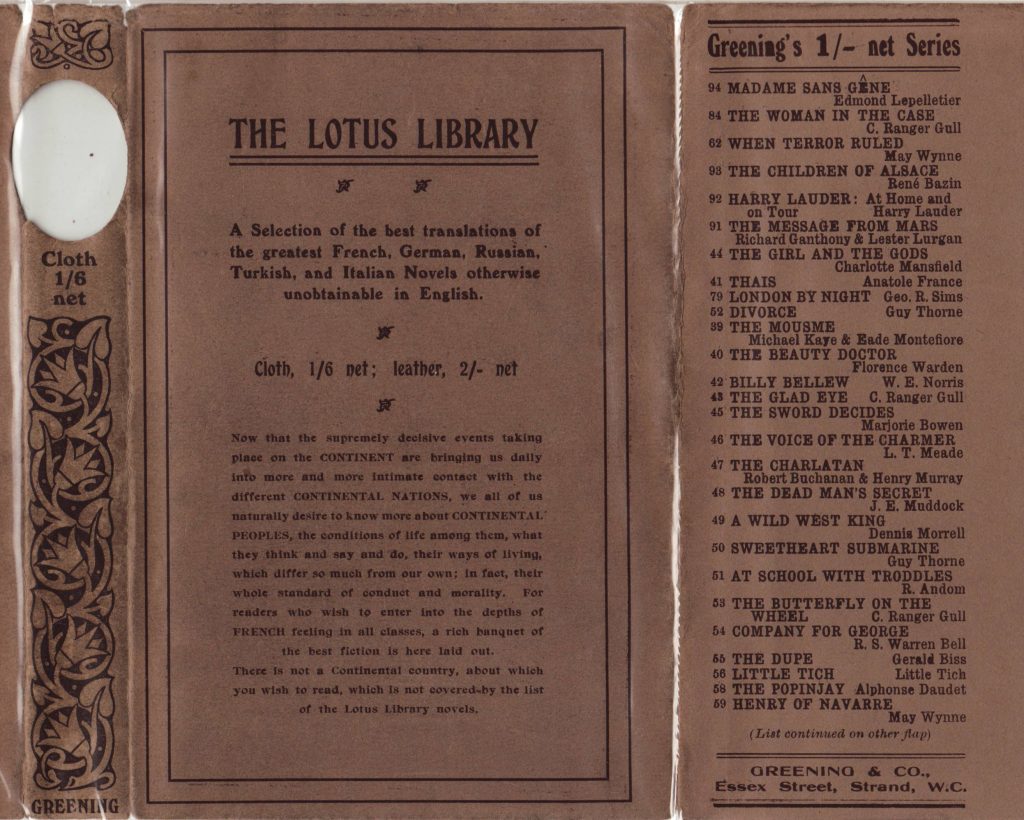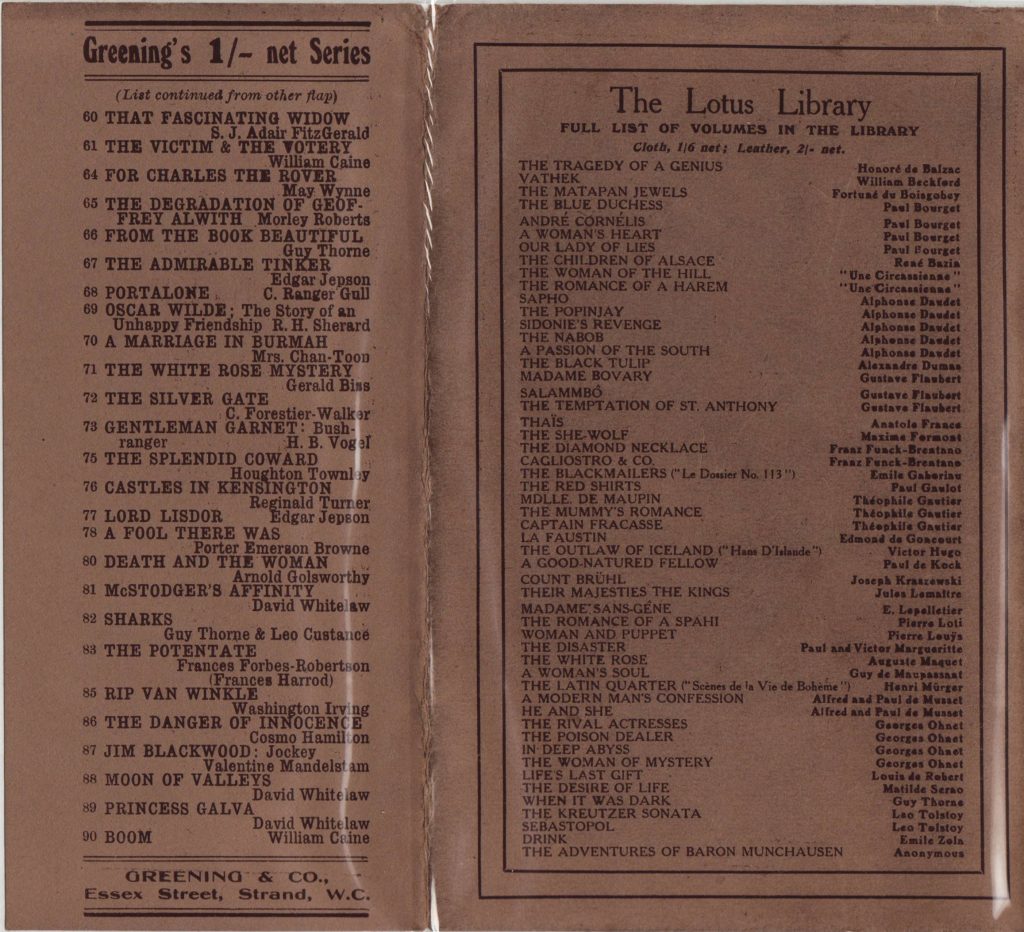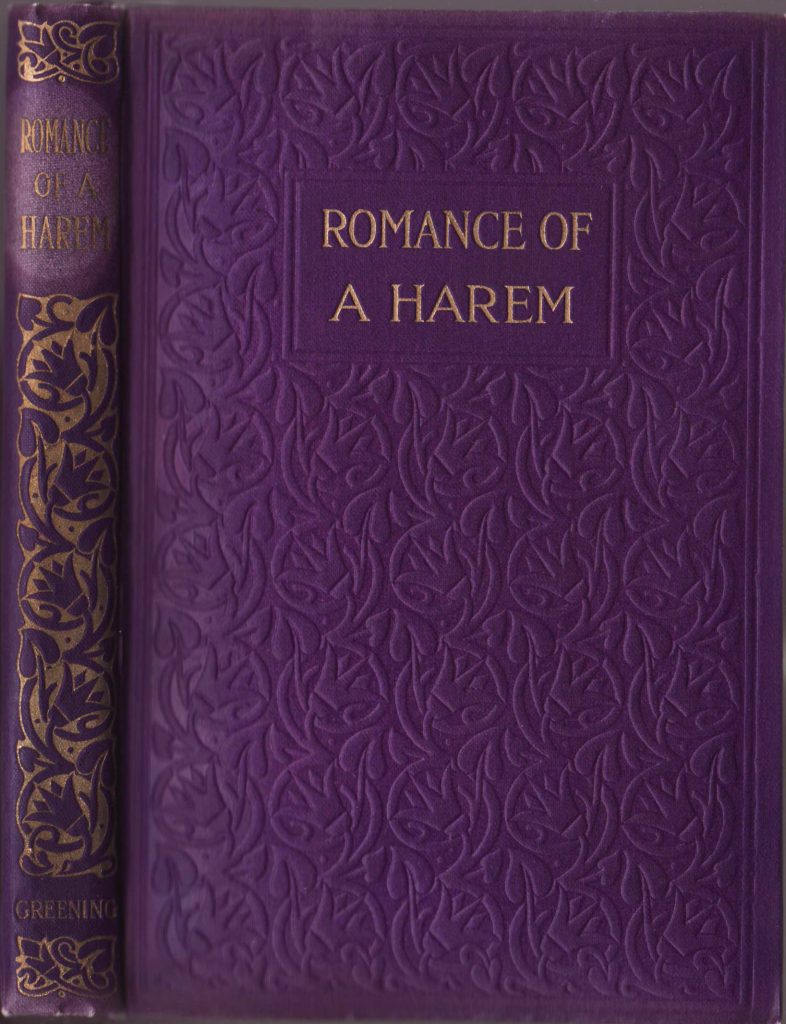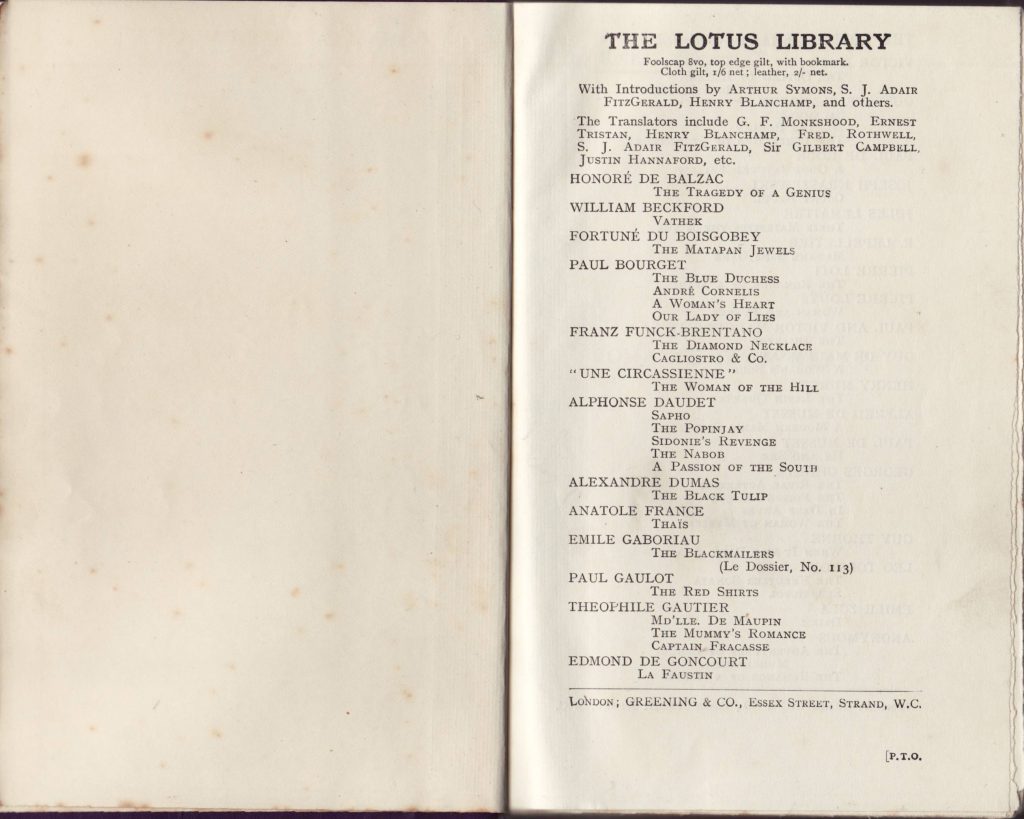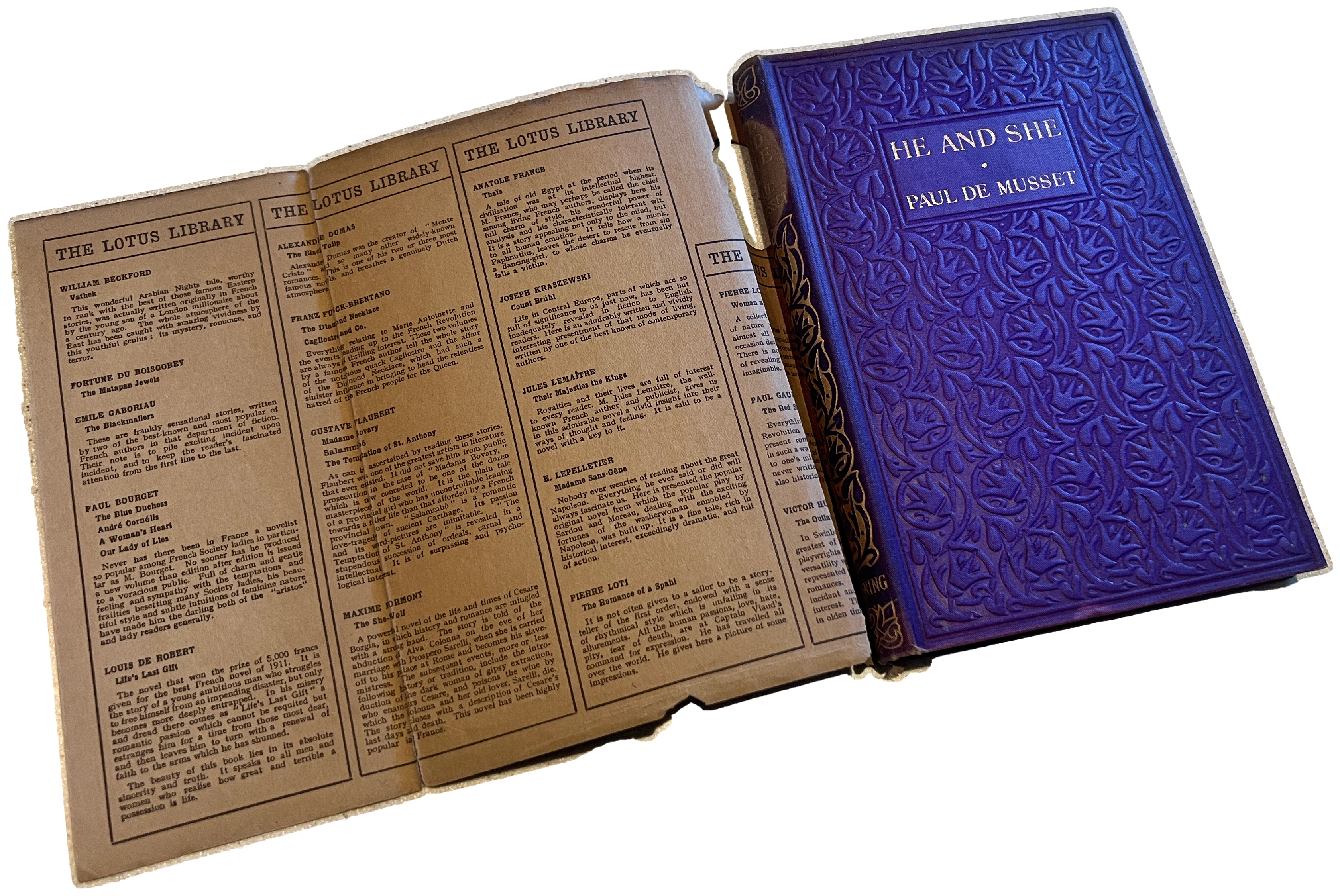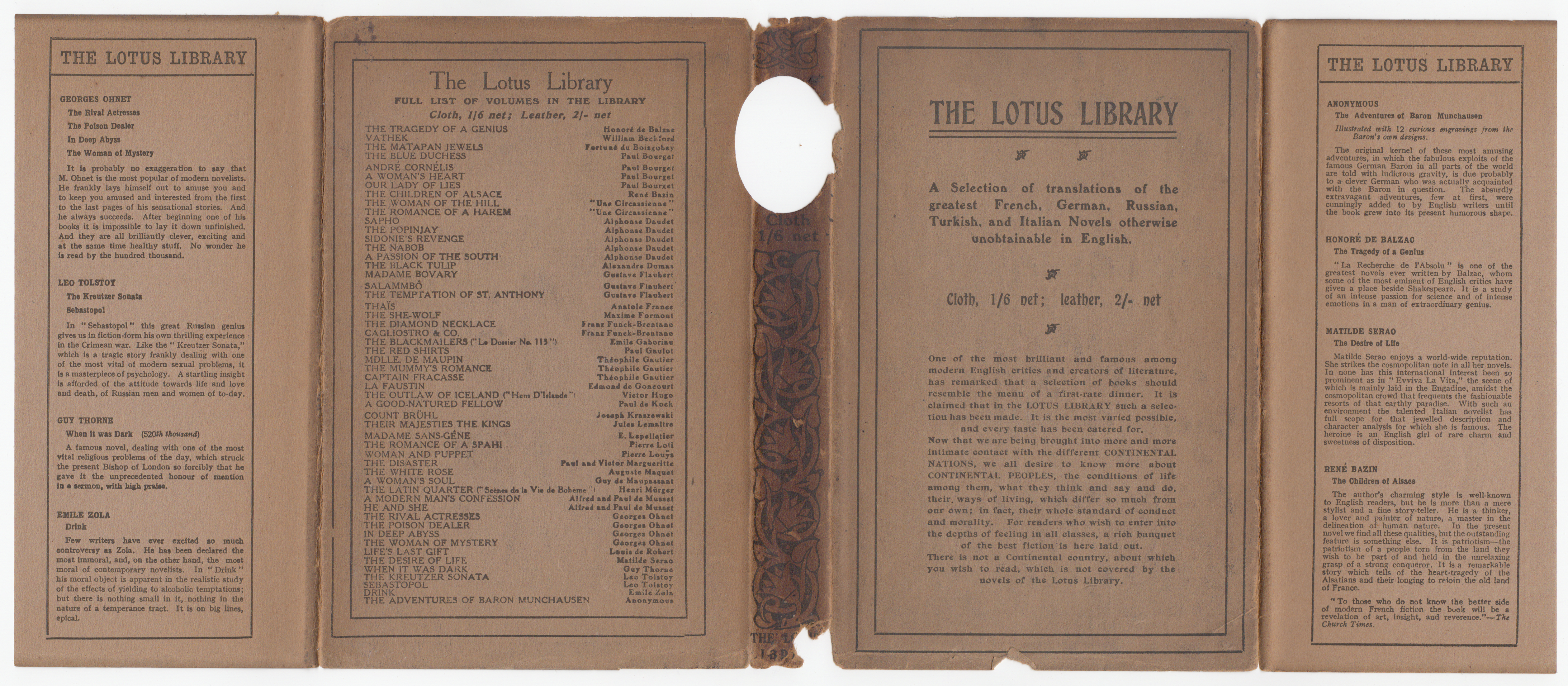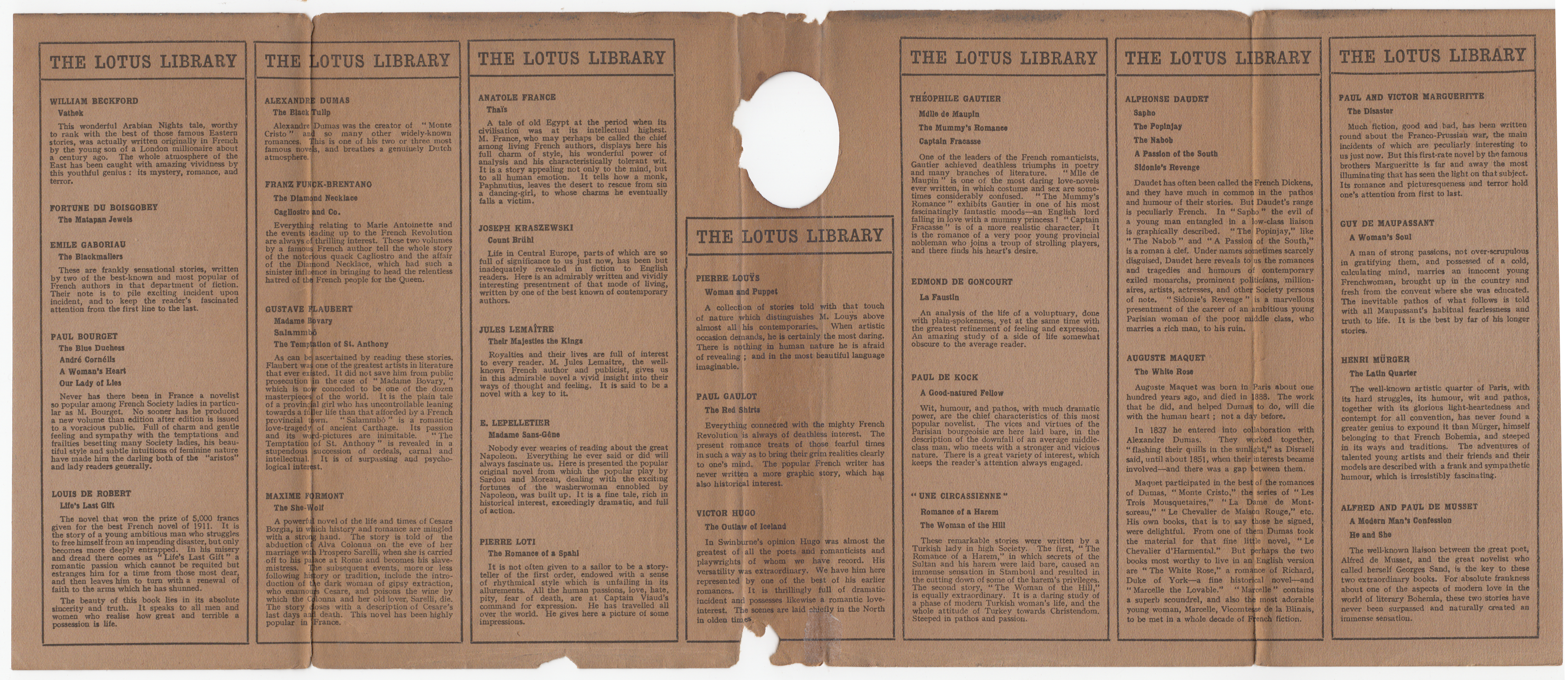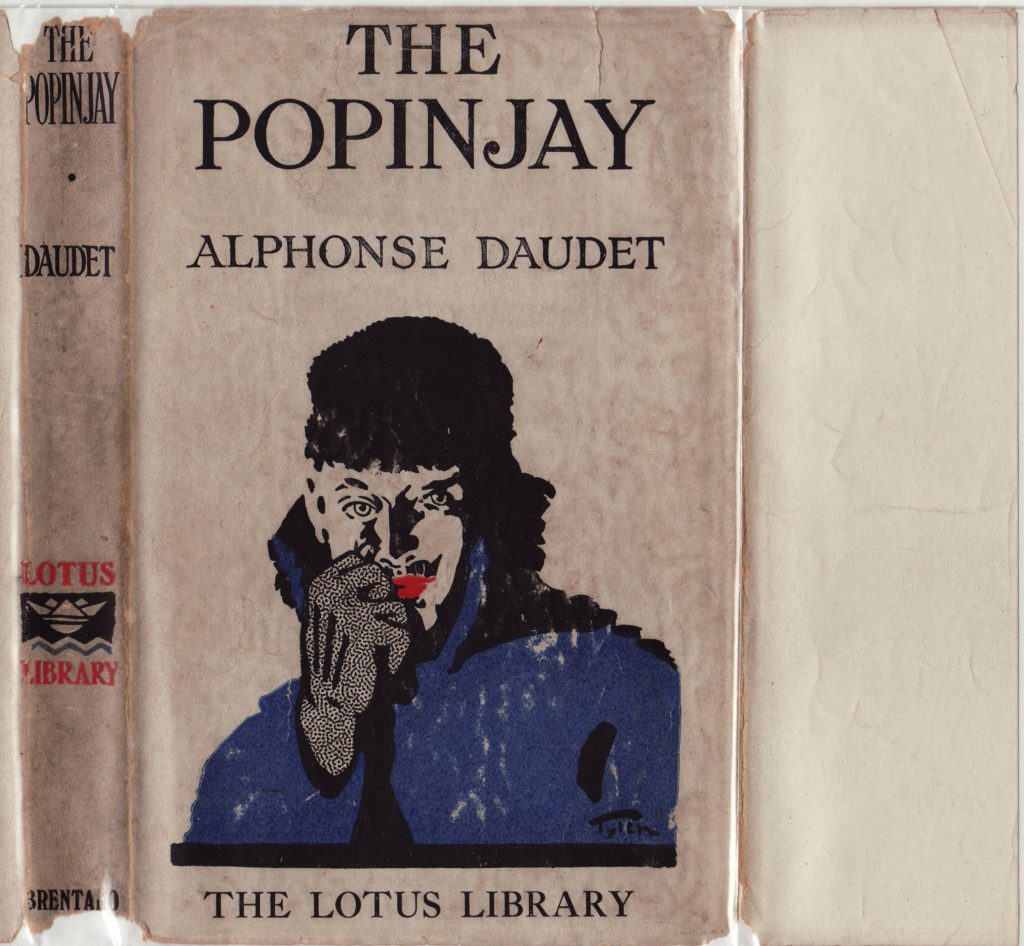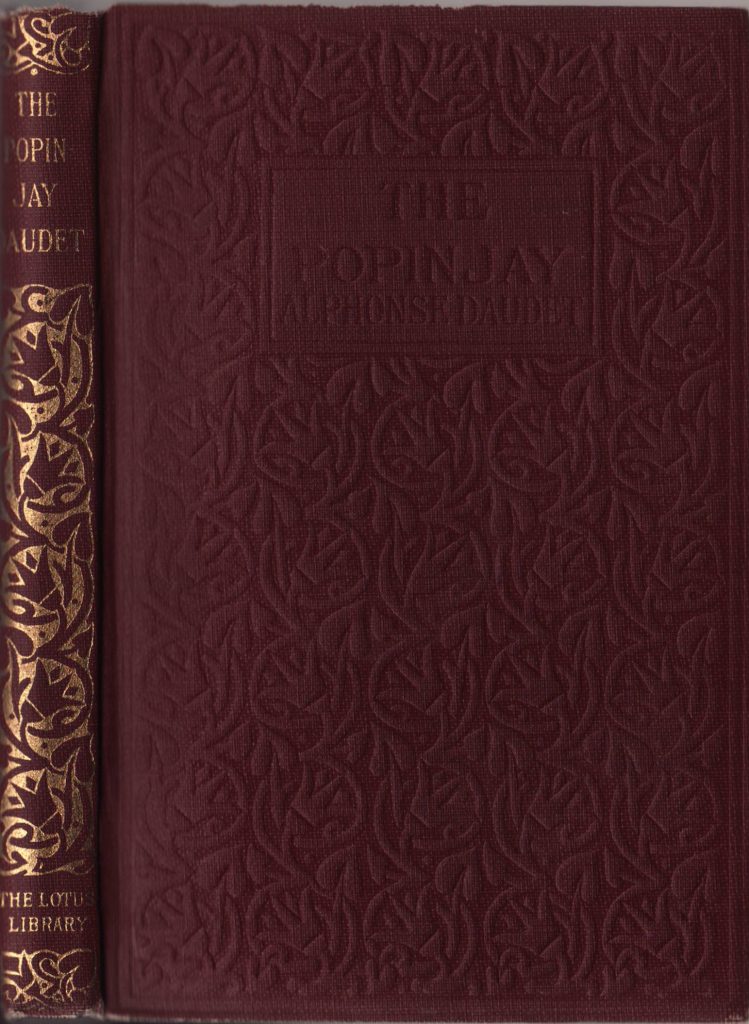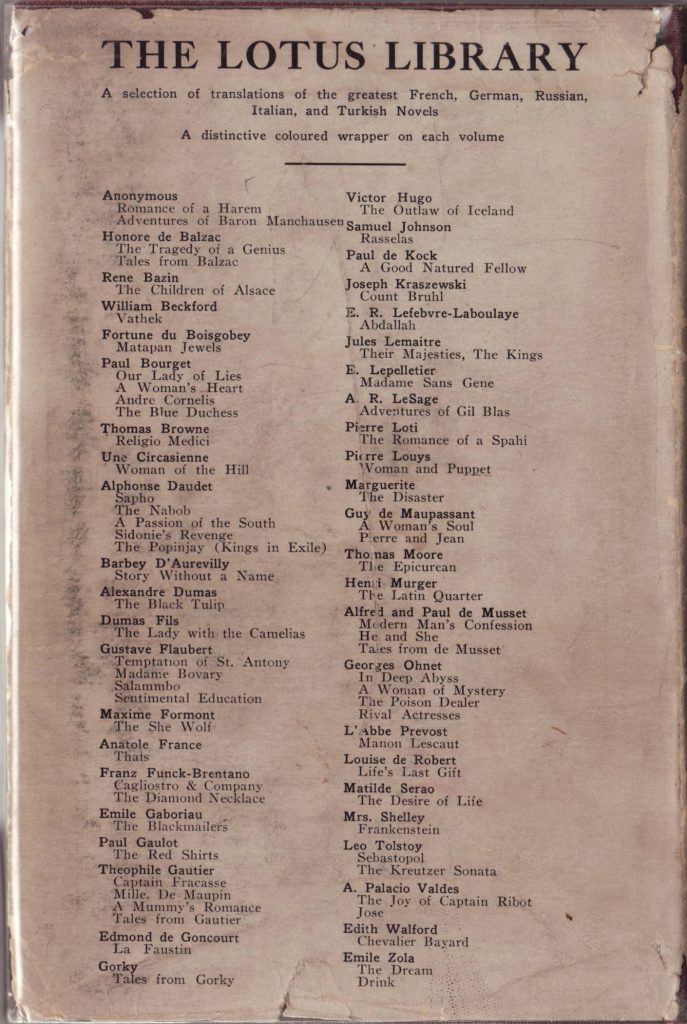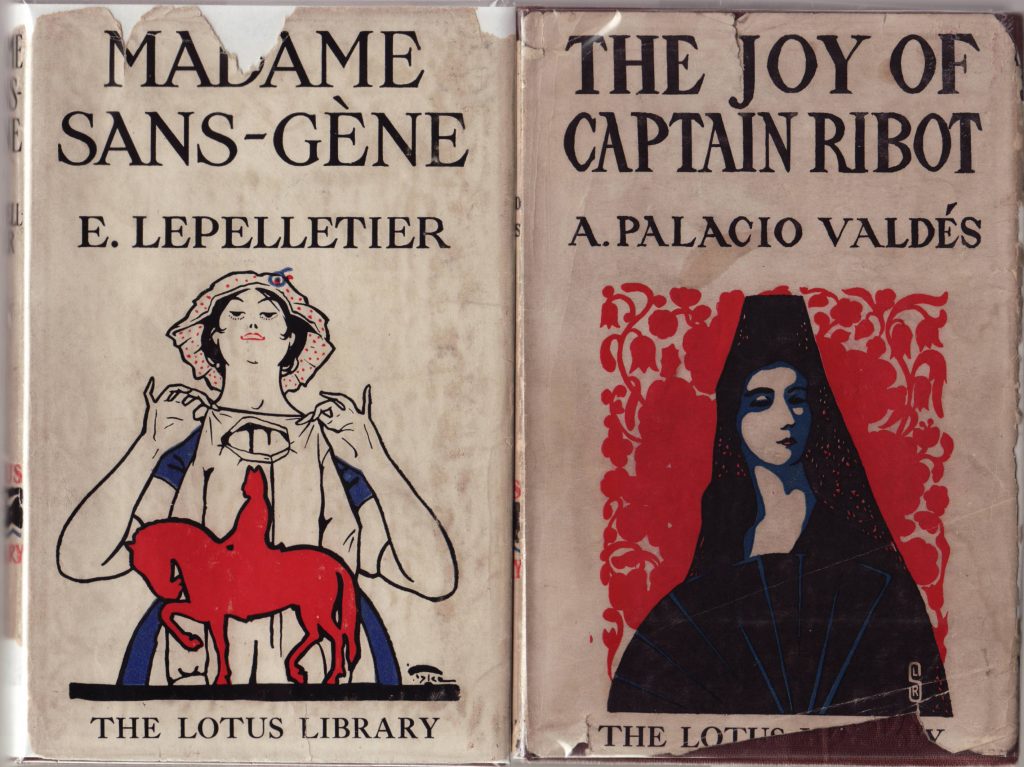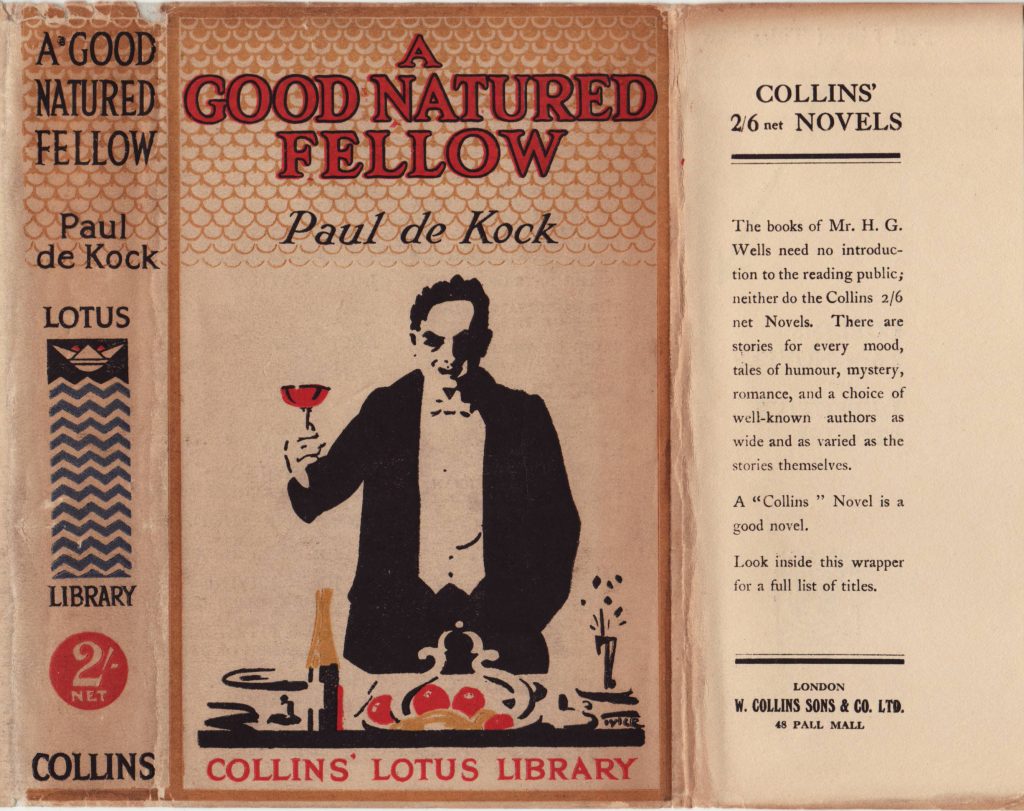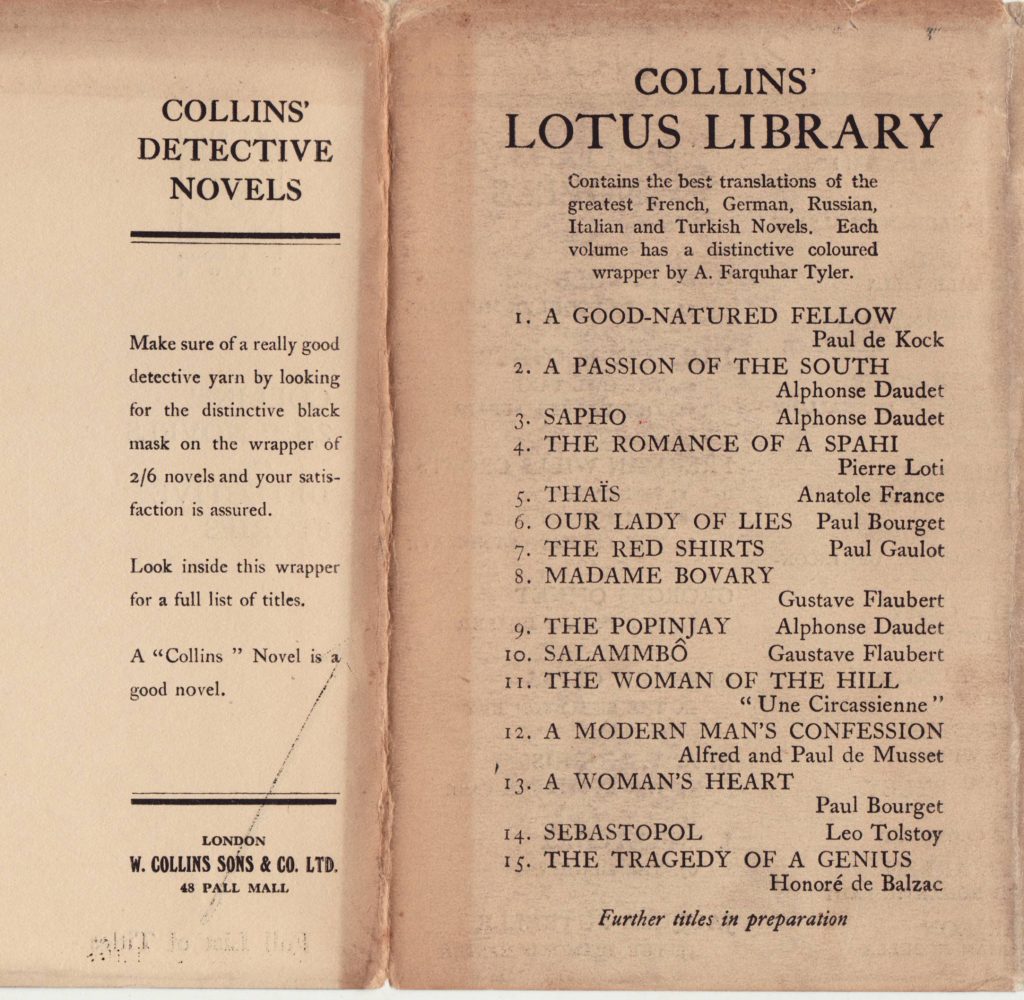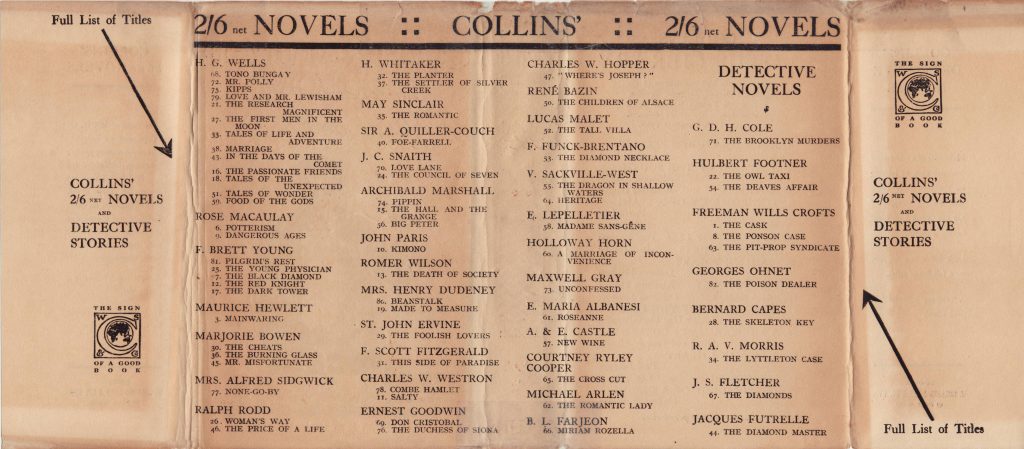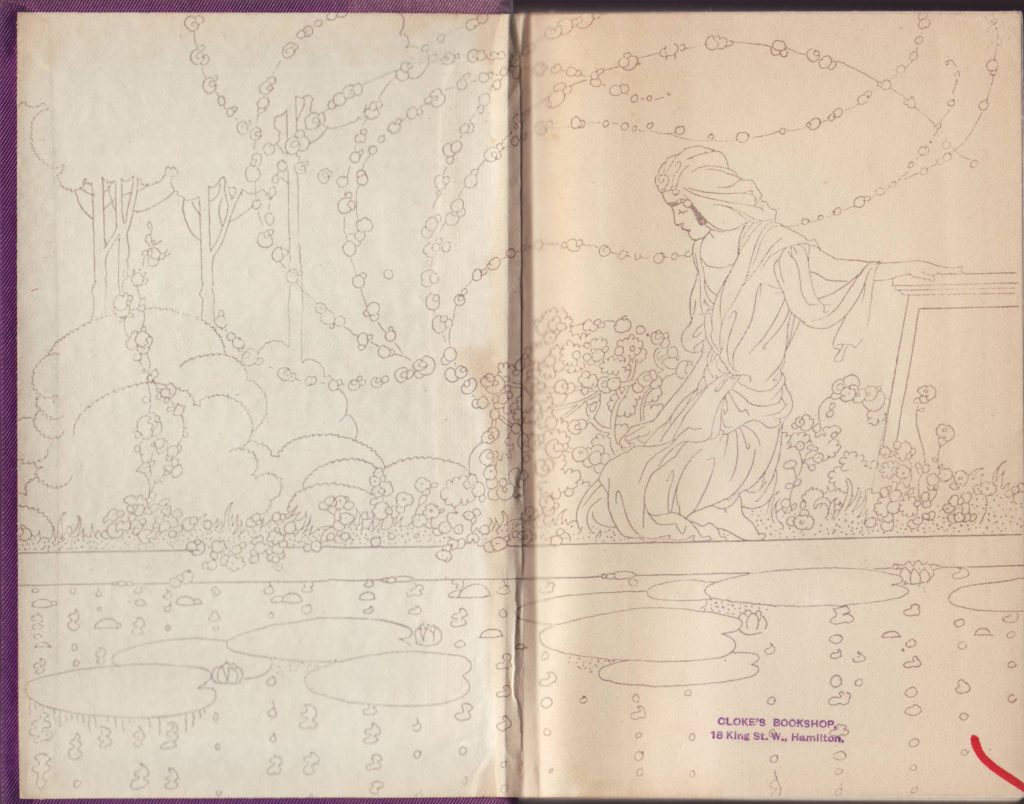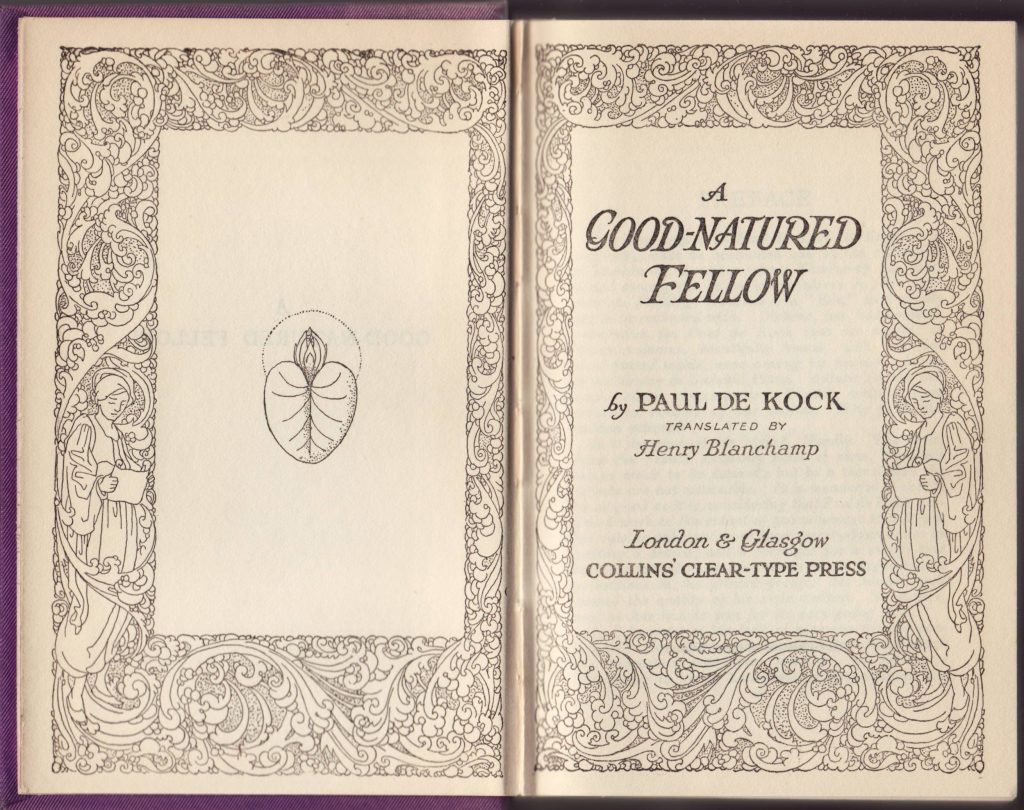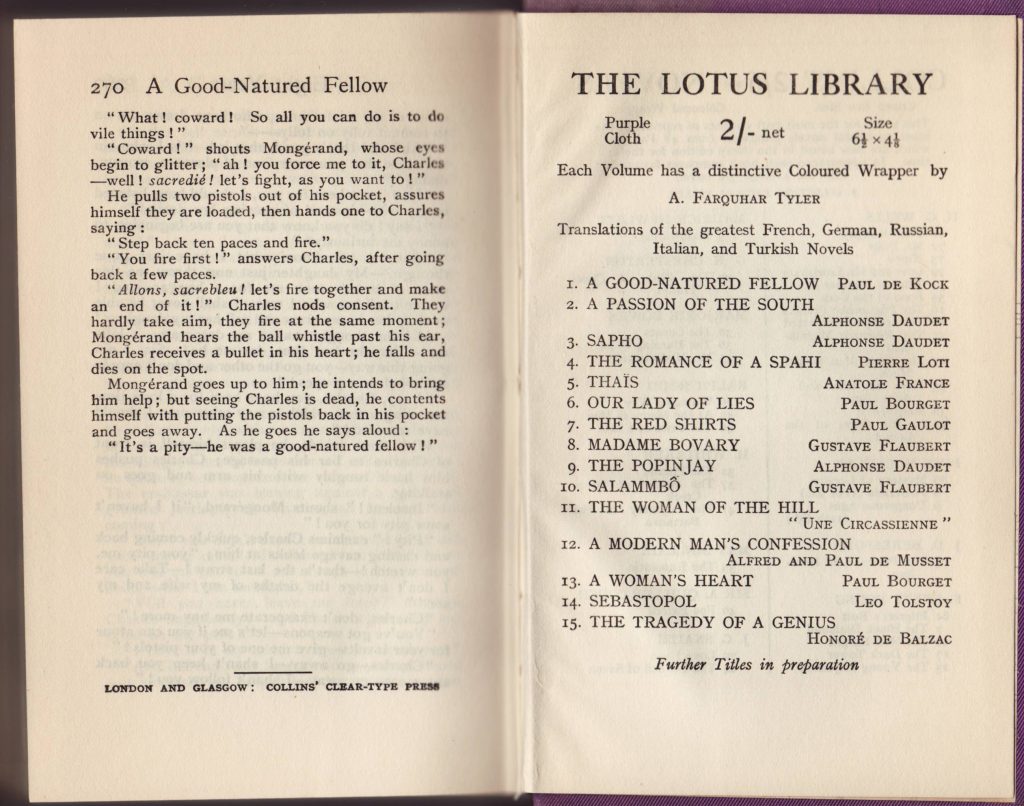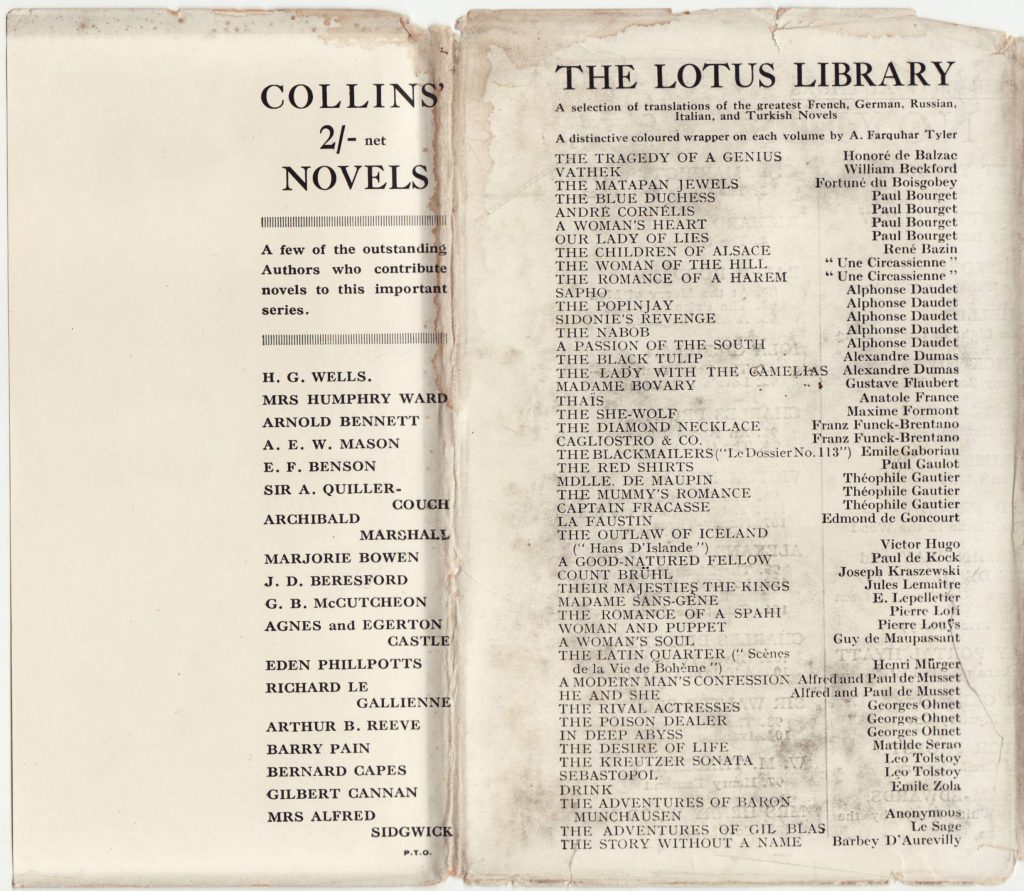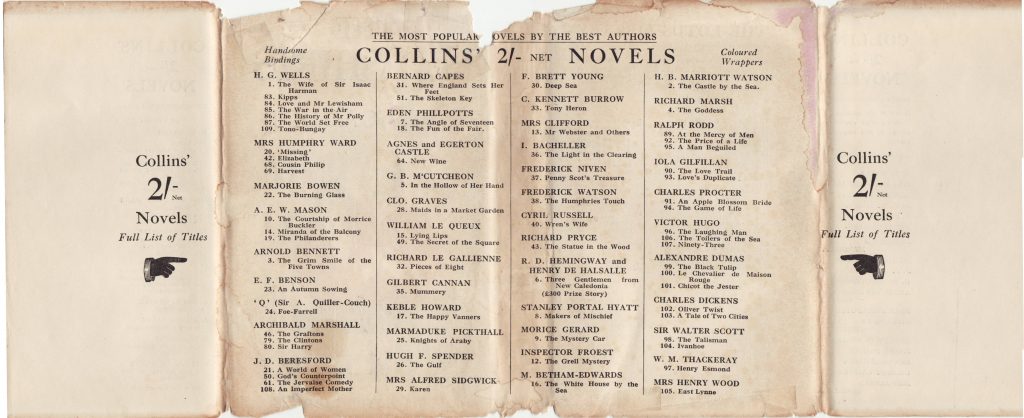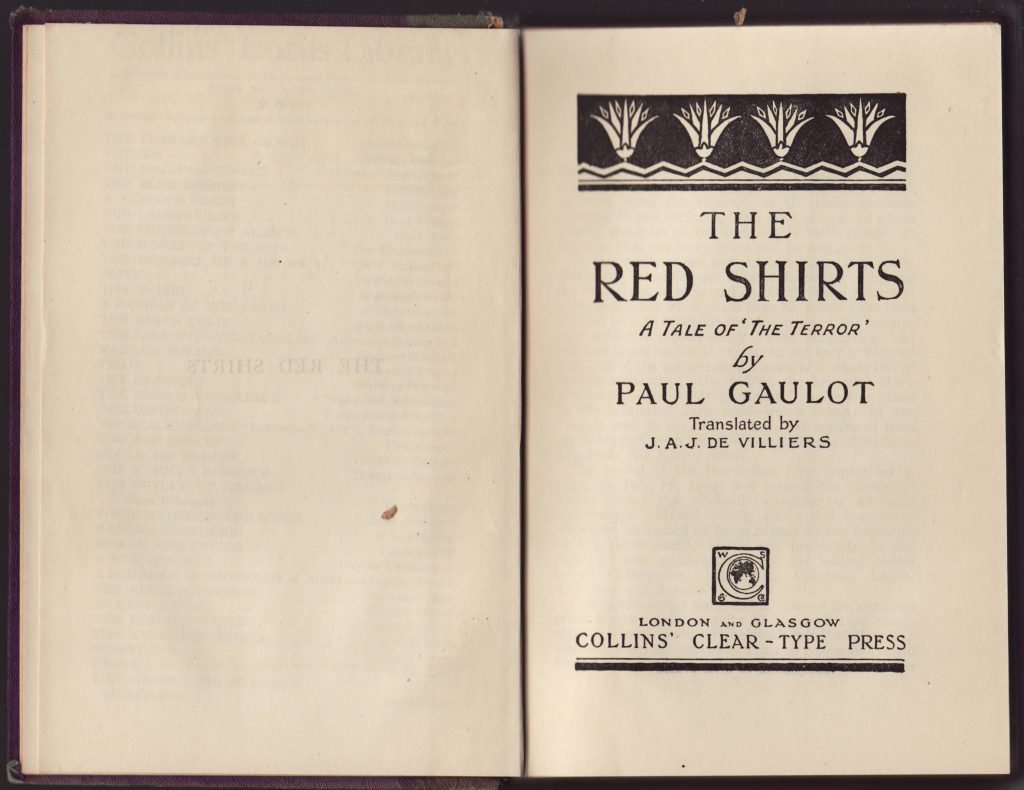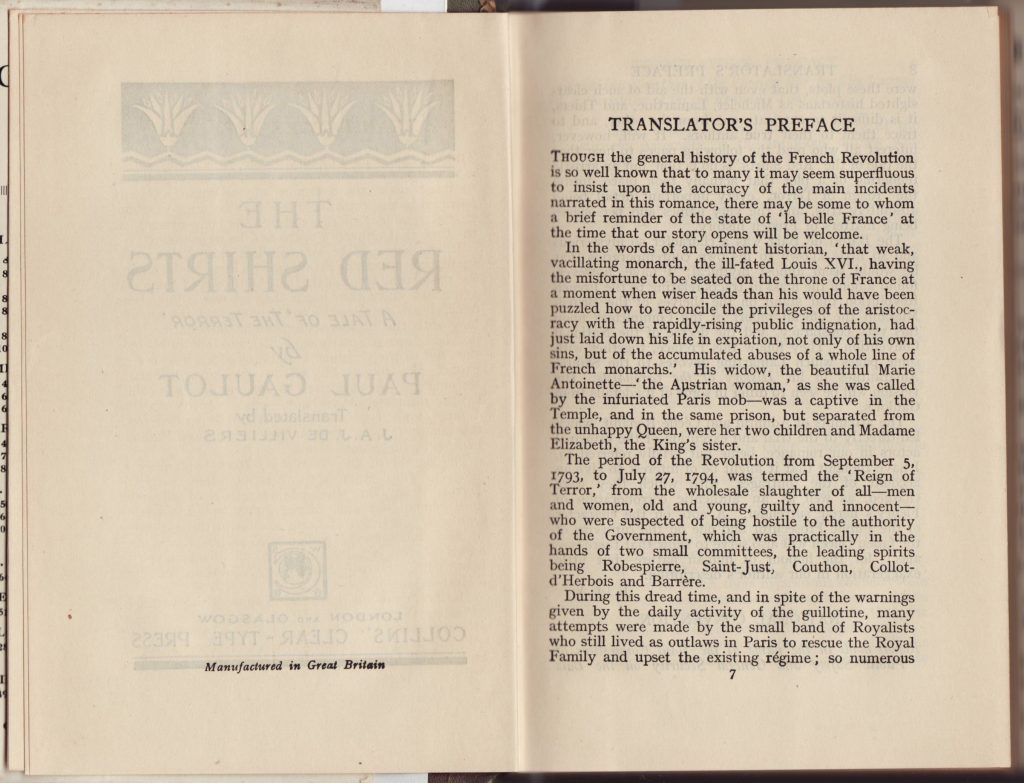Greening and Co. (London, UK) (Imprint of Stanley Paul & Co. after 1913)
Series dates: 1902-1913
Size: 6.5″ x 4″
Brentano’s (New York, US)
Series dates: 1915-1930
Size: 6.5″ x 4″
Stanley Paul & Co. (London, UK)
Series dates: 1913-1920
William Collins & Sons (London, Glasgow, UK)
Series dates: 1920-1930
Size: 6.5″ x 4″
Updated 10/27/2024
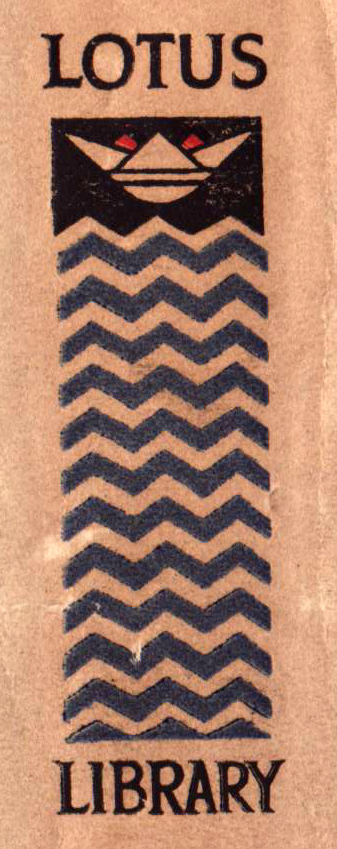 With its whiff of the exotic, the Lotus Library name was initially used for a U.S. series (represented by only one entry in WorldCat) published by the Lotus Publication Company in Chicago in 1892.
With its whiff of the exotic, the Lotus Library name was initially used for a U.S. series (represented by only one entry in WorldCat) published by the Lotus Publication Company in Chicago in 1892.
The 20th-century Lotus Library series, issued by four publishers in the UK and US, shared titles (translations) and some design components. Greening initiated the UK series in 1902. Titles appeared in common text dust jackets. After that, the story gets a bit complicated.
In 1913, Stanley Paul & Co. acquired Greening and maintained that firm’s name as an imprint. Stanley Paul & Co. advertised the series, but most Lotus Library books had a Greening imprint.
The evidence is scarce, but it seems as if Brentano began publishing the series in the US around 1915. This is confused by the inclusion of copyright (not printing) dates in Brentano’s Lotus Library titles (this is also an issue with Greening and Collins copies).
Collins purchased the series from Stanley Paul in 1920, according to this source.
The problem is the distinctive dust jackets by A. Farquhar Tyler, which appear on every copy of the Brentano’s and Collins Lotus Library titles I own and have seen. Every Greening Lotus Library title I’ve seen is in a plain text jacket. Tyler is an obscure figure who seems British (see below). If I had to guess, I’d say that the Tyler jackets were arranged by Collins when they reissued the series in 1924.
 |
From The Publishers’ Circular and Booksellers’ Record, Volume 120, March 15, 1924. |
The jacket design seems more mid-1920s than mid-1910s. But that leaves nearly a decade of Brentano’s Lotus Library titles issued before the Tyler jackets – and, as said, I’ve never seen anything but the Tyler jacket on the Brentano’s Lotus Library—all in all, a bit of series history that is yet to be cleared up.
Collins UK Lotus Library and Brentano’s US Lotus Library stopped being advertised around 1930.
Arthur Greening began publishing in 1897 with little capital, but a few manuscripts and printers were willing to take a risk on the new venture. According to one source, “Arthur W. Greening was born Arthur W. Collins.” This, of course, is confusing given the later acquisition of the series by William Collins & Sons. The company became Greening & Co. Ltd. in 1899. Greening’s Lotus Library began in 1902, after earlier success with a few translated novels.
Increasing competition from an explosion in regular price and cheap editions of titles around 1910 led to the company’s assets being sold off, including some more successful titles (for example, The Scarlet Pimpernel, in 1912). The firm was sold in 1913 to Stanley Paul & Co.
In 1920, Stanley Paul & Co. sold the series to William Collins & Sons. One source claims that Collins “discarded the name and format,” but it seems that Collins acquired the plates for Lotus Library titles and became its sole European publisher. (Source: Cecily Close, “Arthur Greening, Publisher of The Scarlet Pimpernel,” The LaTrobe Journal, 1986). Brentano’s was issuing the series in the US around 1915. Ultimately, the Brentano’s and Collins series were interrelated, using the same jacket art and text blocks printed in the UK in many instances (and bound and jacketed for the US market).
In 1909 and 1910, a kerfuffle played out in issues of The Academy, where a pair of “French authors” in the Lotus Library were accused of obscenity. I have yet to track down details of which authors were involved, but this moral panic, like others, likely did nothing but sell more books.
Another curiosity is the comments about the translation of Flaubert’s Madame Bovary, first published in the Lotus Library in 1905. These comments reveal one of the lesser-known characteristics of reprint series: titles were at times heavily edited, expurgated (especially if in series aimed at young adults), and sometimes mercilessly chopped down to fit a set page limit (for cost savings; see the F.P. Library for an example). The editing, for a “popular” audience, with a possible need to keep the page count down, seems to have been part of the 1905 translation of Madame Bovary published in the Lotus Library. Quotes below are from a review of Madame Bovary translations, quoted from “Flaubert and the retranslation of Madame Bovary” (2011) by Sharon Deane:
“…there is a gap of almost thirty years which separates the publication of the source text and the appearance of the initial British version in 1886, translated by Eleanor Marx-Aveling, daughter of Karl Marx, and published in London by Vizetelly & Co.”
The first translation after Marx-Aveling was “…published in the Lotus Library series of Greening & Co. in 1905 and “done into English” by Henry Blanchamp (almost two decades after the Marx-Aveling translation), this version is, like that of Saintsbury, partial. However, on this occasion, the guiding principle may have been one of brevity, if not of expurgation, particularly towards the end of the novel.”
“Judging by the size of the work (8°) and its relatively low price tag of 1/6d, it is to be presumed that this particular Lotus Library series, which also issued translations of Maupassant, Musset, and Zola, had a more popular audience in its sights. Whether the cuts made to the source text were done so out of a sense of catering for this new readership – whose attention spans were perhaps not so developed as those of the literary elite –, or out of a sense of cautious propriety is unclear. Nonetheless, in respect of this latter point, it is evident that, while religiously sensitive material may have been deliberately removed, all seduction scenes and a good part of the death scene remain intact.”
The book below, The Romance Of A Harem (by “Une Circassienne” in some lists), is undated (initially published in the series in 1904) but no earlier than 1912, given the new books advertised on the back of the book (The Court Series of French Memoirs). This would put the book near the end of Greening’s Lotus Library series (although reprints continued with the Greening imprint until at least 1920). The binding is the same as used for Collins’ later versions of the Lotus Library. Thus, this may be a later printing, after 1920, by Collins of a Greening series title. Confusing! Series were bought and sold (including plates and unbound and bound stock) and sold or reprinted when demand existed; if it was legal and cheaper to reprint a Lotus Library book with all the Greening’s indicators on it, that is what would happen.
This jacket is entirely generic, with no indication of the title on the jacket itself. A hole (“factotum aperture”) was cut (by the printer) in the jacket so that the title on the book’s spine was visible. This kind of jacket could be used on any book in the series and was probably a cost-saving measure. Earlier jackets (from internet sellers) have jackets with the titles and author indicated. The price (1/6) is printed on the jacket spine.
The jacket cover lauds the series and its array of translations. A paragraph describes the growing curiosity among the British about those who live on the Continent and beyond Europe. This series, then, provides insights via literature to address that curiosity. Greening’s 1/- Series (of copyright fiction) is advertised on the front and rear jacket flaps.
A list of titles available in the series at the time is included on the back of the jacket.
Bindings are an exotic purple, with the same lotus flower design as Collins’ Lotus Library.
The front of the book contains another list of titles in the series, organized by author.
The list of titles continues:
Another advertisement for the series faces the title page.
A copy of Paul de Musset’s He and She in Greening’s Lotus Library is dated 1910. It has the same generic jacket with a hole (factotum aperture) in the jacket spine to reveal the title and author as the Romance of a Harem title above.
 The jacket inside and flaps include an annotated listing of 53 titles in the series.
The jacket inside and flaps include an annotated listing of 53 titles in the series.
The front and back of the jacket can be enlarged for the annotated list of titles in the Lotus Library (as of 1910).
The Greening-era Lotus Library titles did have assigned series numbers, but the numbering is not evident on the two books shown here, and at least three numbering schemes can be found. The three numbered lists from 1912, 1913, and 1916 are shown below.
Given the lack of consistency in numbering, I’m skipping an attempt to assign series numbers to the titles in the list below simply because a single book can have three (or more) series numbers (when you add additional information from titles in WorldCat). In addition, Brentanos had a separate numbering system for their US copies of the series.
A 1912 copy of the Lotus Library title The Romance of a Spahi by Pierre Loti contains a list of 50 titles. 
A 1913 copy of the Greening & Co. title The Merchant of Venice, Told by a Popular Novelist, contains a list of 52 titles, numbered differently than the list above (and in reverse order).
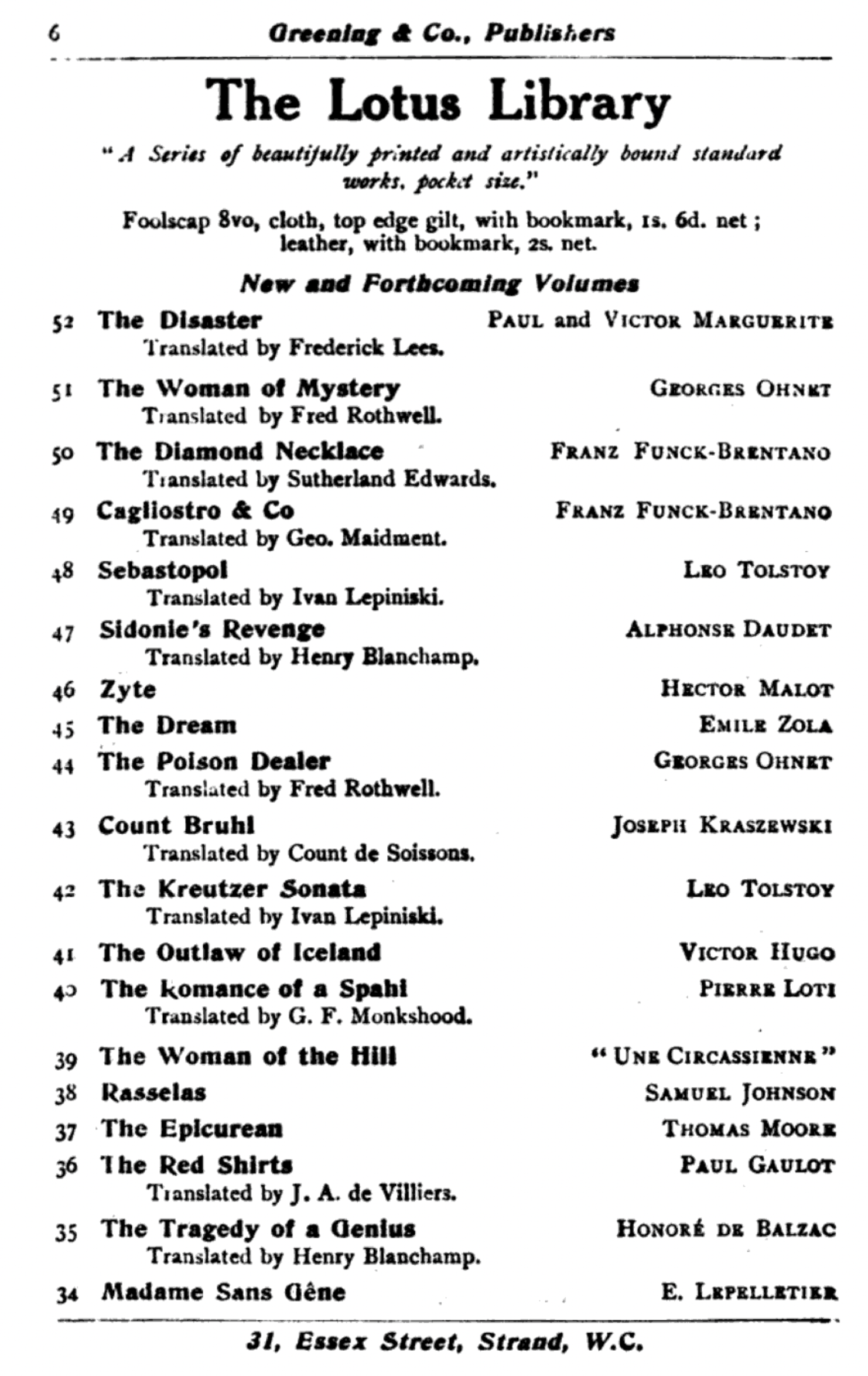 |
 |
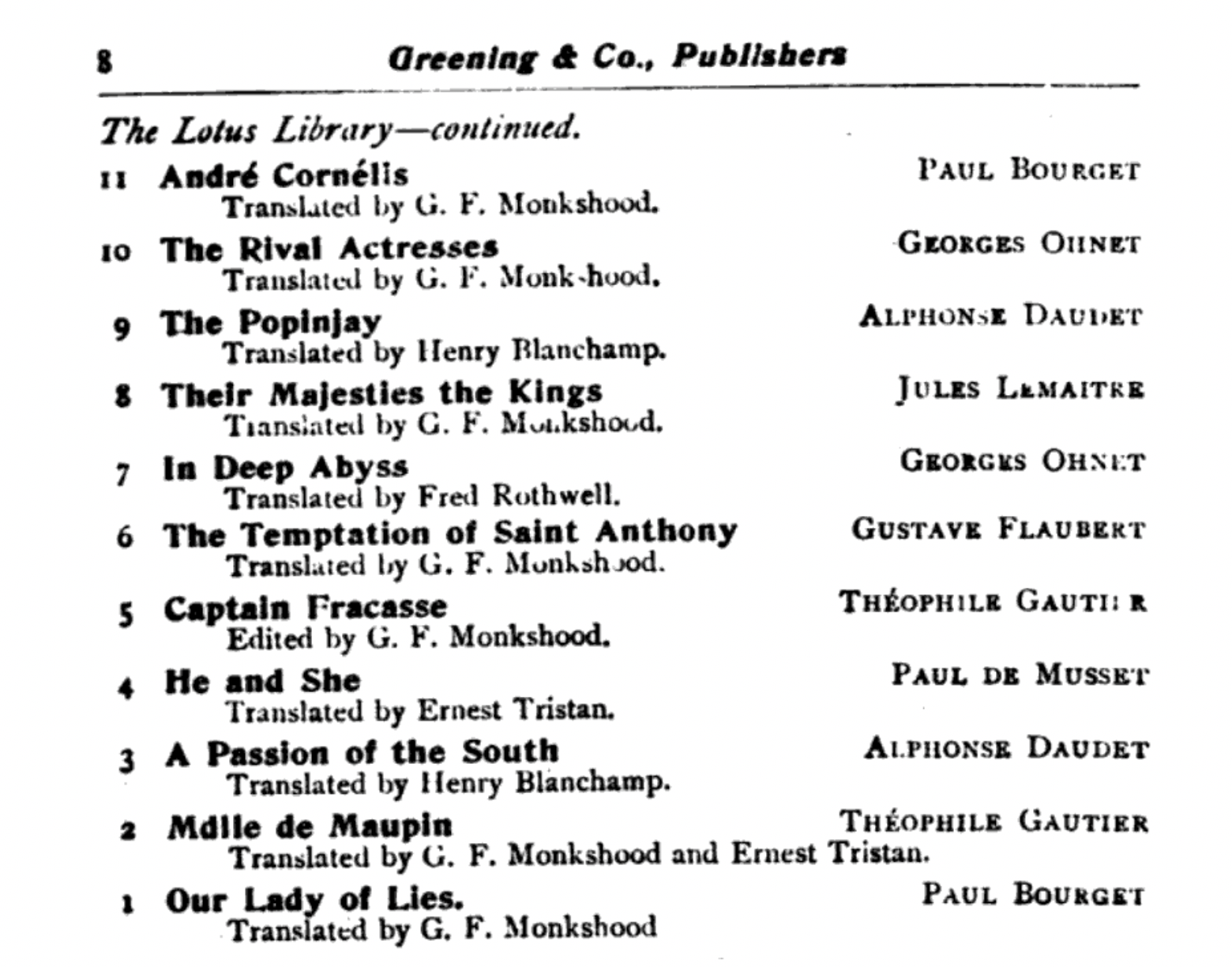 |
An advertisement from The Bookseller (October 1916) includes a “full list of titles” with series numbers. The titles are arranged by author, as in the list on the copy of He and She (above). This numbering also differs, for the most part, from the previous two numbered lists.
In all, 60 titles in the Greening & Co. era Lotus Library are listed below by the author’s surname. The list includes titles removed from the series which don’t appear in later lists. Publication years are compiled from entries on WorldCat and actual titles seen on eBay, Abebooks.com, Biblio.com, and a general internet search. The dates are undoubtedly incomplete.
The Adventures Of Baron Munchausen, by Anonymous (1907)
The Tragedy of a Genius, by Honore De Balzac (1912)
The Children Of Alsace, by Rene Bazin (1915)
Vathek, by William Beckford (1905)
The Matapan Jewels (aka, The Matapan Affair) by Fortune de Boisgobey (1908)
Andre Cornelis, by Paul Bourget (1909)
The Blue Duchess, by Paul Bourget (1907, 1908)
Our Lady Of Lies, by Paul Bourget (1910)
A Woman’s Heart, by Paul Bourget (1909)
**Zyte, by Hector Chalot (1911)
The Romance Of A Harem, by “Une Circassienne” (1904, 1905, 1916)
The Woman Of The Hill, by “Une Circassienne” (1902)
A Passion Of The South, by Alphonse Daudet (1910, 1919)
The Nabob, by Alphonse Daudet (1902, 1916)
The Popinjay, by Alphonse Daudet (1909)
Sapho, by Alphonse Daudet (1902, 1905)
Sidonie’s Revenge, by Alphonse Daudet (1911)
The Black Tulip, by Alexander Dumas (1906)
The Lady with the Camelias, by Alexandre Dumas (1916) (source).
Madame Bovary, by Gustave Flaubert (1905)
Salammbo, by Gustave Flaubert (1901, 1908)
*The Temptation Of St. Anthony, by Gustave Flaubert (1910)
The She-Wolf, by Maxime Formont (1913)
Thais, by Anatol France (1902, 1903)
Cagliostro & Co., by Franz Funck-Brentano (1910)
The Diamond Necklace, by Franz Funck-Brentano (1911)
The Blackmailers (“Le Dossier No. 113”), by Emil Gaboriau (1907)
The Red Shirts, by Paul Gaulot (1912)
Captain Fracasse, by Theophile Gautier (1910)
Mdlle. De Maupin, by Theophile Gautier (1910, 1911, 1920)
The Mummy’s Romance, by Theophile Gautier (1908, 1909)
La Faustin, by Edmond de Goncourt (1906)
The Outlaw Of Iceland (“Hans D’Islande”), by Victor Hugo (1912)
*Rasselas, by Samuel Johnson (1911)
A Good-Natured Fellow, by Paul de Kock (1909)
Count Bruhl, by Joseph Kraszewski (1911)
Their Majesties The Kings, by Jules Lemaitre (1909)
The Adventures of Gil Blas of Santillane, by Alain René Le Sage (1917) (source)
Madame Sans-Gene, by E. Lepellaitre
The Romance of a Spahi, by Pierre Loti (1912)
Woman And Puppet, Pierre Louys (1907, 1908)
**The White Rose, by Auguste Maquet (1912)
*The Disaster, by Paul and Victor Margueritte (1911)
A Woman’s Soul, by Guy de Maupassant (1907, 1911, 1922)
*The Epicurean, by Thomas Moore (1911)
The Latin Quarter (“Scenes de la Vie de Boheme”), by Henri Murger (1908, 1910, 1913, 1915, 1940)
A Modern Man’s Confession, by Alfred and Paul de Musset (1908)
He And She, by Alfred and Paul de Musset (1910)
In Deep Abyss, by George Ohnet (1910)
The Poison Dealer, by George Ohnet (1911)
The Rival Actresses, by George Ohnet (1909)
*The Woman of Mystery, by George Ohnet (1911)
*Life’s Last Gift, by Louis de Robert (1915, 1924)
The Desire Of Life, Matilde Serao (1911, 1916)
**Sweetheart Submarine, by Guy Thorne (1911)
**When It Was Dark, by Guy Thorne (1906)
The Kreutzer Sonata, by Leo Tolstoy (1911)
Sebastopol, by Leo Tolstoy (1911)
*The Dream, by Emil Zola (1911)
Drink, by Emile Zola (1907)
*not included in Collins Lotus Library
**not included in the US Brentano’s Lotus Library nor Collin’s Lotus Library
Three mistaken Lotus Library entries from WorldCat:
The Pongo Papers and the Duke of Berwick, by Alfred Bruce Douglas (1907) (Cataloging error likely due to Lotus Library list in the book.)
The Battle of the Books; and, Directions to Servants, by Jonathan Swift (1907; Lotus Library and “Complete works; vol. 3.” Cataloging error likely due to Lotus Library list in the book).
Woman and the Wise, by G.F. Monkshood (1907; Lotus Library & “Greening’s Special Publications.” Cataloging error likely due to Lotus Library list in the book)
Brentano’s began as a newsstand in New York City in 1853. Eventually, there were stores in New York, Washington DC, Chicago, Paris, and London. Brentano’s was eventually acquired by Waldenbooks/Borders (in the mid-1980s).
“From its headquarters at 586 Fifth Avenue, Brentano’s became a publisher, with a specialization in French literature that led it to publish under the imprint “Éditions Brentano’s” many titles by French writers in exile during the Vichy France period. In an attempt to prevent the possible liquidation of the company, the publishing department was sold to Coward-McCann in 1933.” (source).
Brentano’s Lotus Library series began publication in 1915 and consisted of 70 numbered titles and two additional unnumbered titles. One numbered title (69) and the two unnumbered titles may be ghost titles. Thus, Brentano’s Lotus Library consisted of 69 to 72 titles.
The first 56 titles were drawn from Browning’s UK series. Unlike Greening titles (and later Collins titles), Brentano’s Lotus Library series numbers were consistent.
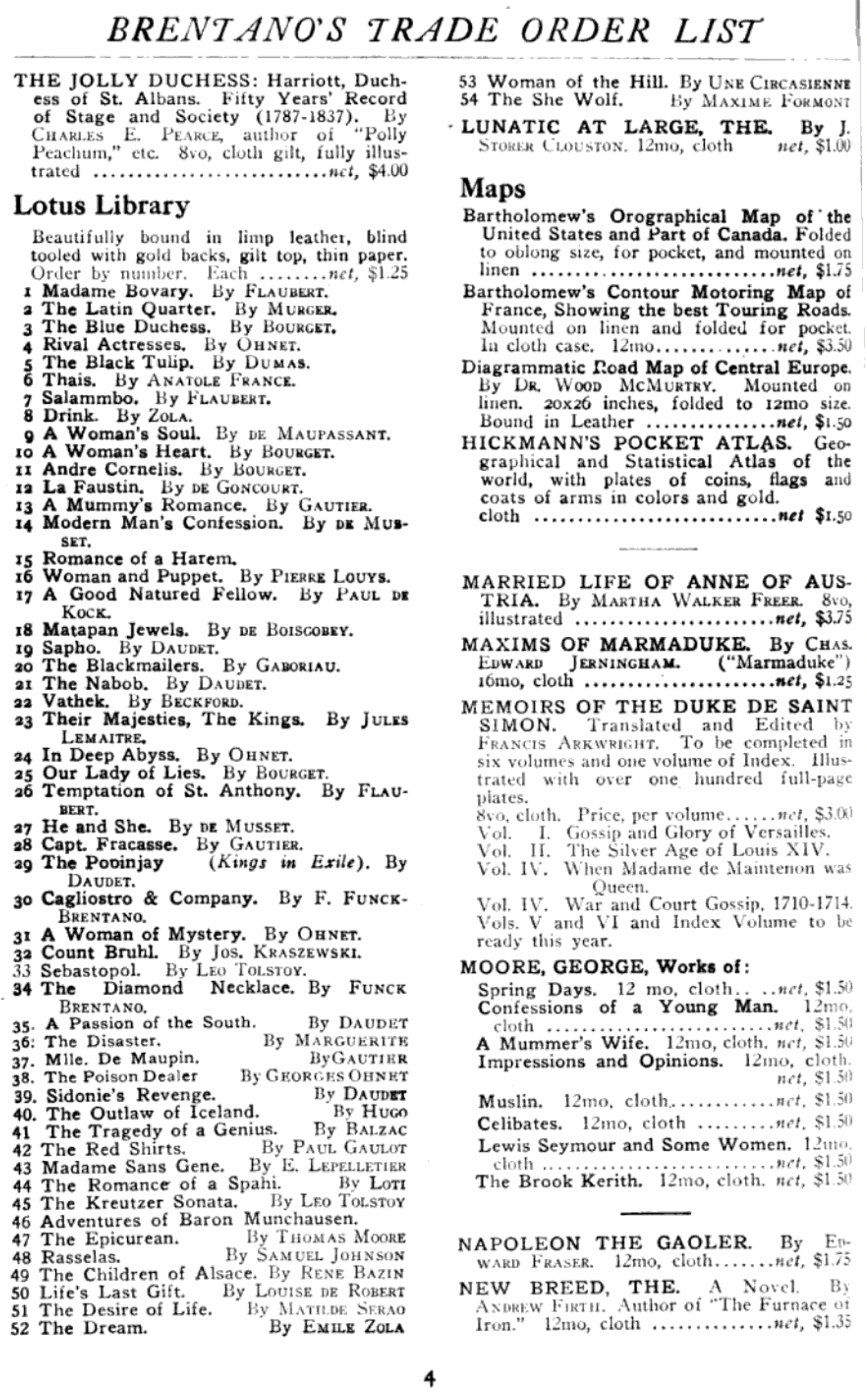 |
A list of 54 numbered titles in Brentano’s US version of the Lotus Library can be found on Page 4 of Brentano’s Trade Order List published in the June 1917 issue of The Publishers’ Trade List Annual. |
#1. Madame Bovary, by Gustave Flaubert
#2. The Latin Quarter (“Scenes de la Vie de Boheme”), by Henri Murger
#3. The Blue Duchess, by Paul Bourget
#4. The Rival Actresses, by George Ohnet
#5. The Black Tulip, by Alexander Dumas
#6. Thais, by Anatol France
#7. Salammbo, by Gustave Flaubert
#8. Drink, by Emile Zola
#9. A Woman’s Soul, by Guy de Maupassant
#10. A Woman’s Heart, by Paul Bourget
#11. Andre Cornelis, by Paul Bourget
#12. La Faustin, by Edmond de Goncourt
#13 The Mummy’s Romance, by Theophile Gautier
#14. A Modern Man’s Confession, by Alfred and Paul de Musset
#15. The Romance Of A Harem, by “Une Circassienne”
#16. Woman And Puppet, Pierre Louys
#17. A Good-Natured Fellow, by Paul de Kock
#18. The Matapan Jewels (aka, The Matapan Affair) by Fortune de Boisgobey
#19. Sapho, by Alphonse Daudet
#20. The Blackmailers (“Le Dossier No. 113”), by Emil Gaboriau
#21. The Nabob, by Alphonse Daudet
#22. Vathek, by William Beckford
#23. Their Majesties The Kings, by Jules Lemaitre
#24. In Deep Abyss, by George Ohnet
#25. Our Lady Of Lies, by Paul Bourget
#26. The Temptation Of St. Anthony, by Gustave Flaubert
#27. He And She, by Alfred and Paul de Musset
#28. Captain Fracasse, by Theophile Gautier
#29. The Popinjay, by Alphonse Daudet
#30. Cagliostro & Co., by Franz Funck-Brentano
#31. The Woman of Mystery, by George Ohnet
#32. Count Bruhl, by Joseph Kraszewski
#33. Sebastopol, by Leo Tolstoy
#34. The Diamond Necklace, by Franz Funck-Brentano
#35. A Passion Of The South, by Alphonse Daudet
#36. The Disaster, by Paul and Victor Margueritte
#37. Mdlle. De Maupin, by Theophile Gautier
#38. The Poison Dealer, by George Ohnet
#39. Sidonie’s Revenge, by Alphonse Daudet
#40. The Outlaw Of Iceland (“Hans D’Islande”), by Victor Hugo
#41. The Tragedy of a Genius, by Honore De Balzac
#42. The Red Shirts, by Paul Gaulot
#43. Madame Sans-Gene, by E. Lepellaitre
#44. The Romance of a Spahi, by Pierre Loti
#45. The Kreutzer Sonata, by Leo Tolstoy
#46. The Adventures Of Baron Munchausen, by Anonymous
#47. The Epicurean, by Thomas Moore
#48. Rasselas, by Samuel Johnson
#49. The Children Of Alsace, by Rene Bazin
#50. Life’s Last Gift, by Louis de Robert
#51. The Desire Of Life, Matilde Serao
#52. The Dream, by Emil Zola
#53. The Woman Of The Hill, by “Une Circassienne”
#54. The She-Wolf, by Maxime Formont
 |
From Brentano’s Trade Order List, published in the June 1918 edition of the Publisher’s Trade List Annual. |
#55. The Lady with the Camellias, by Alexander Dumas
#56. The Adventures of Gil Blas of Santillane, by Alain René Le Sage
Gil Blas is the last Greening Lotus Library title published by Brentano’s in the US. Subsequent titles were unique to Brentano’s Lotus Library.
Four UK Greening Lotus Library titles—Zyte by Hector Chalot, The White Rose by Auguste Maquet, Sweetheart Submarine by Guy Thorne, and When It Was Dark—are missing from the US Brentano’s Lotus library.
 |
From The Publisher’s Weekly, March 8, 1919. |
The first Lotus Library title unique to the US Lotus Library series is The Story Without a Name, published in 1919.
57. The Story Without a Name, by Barbey D’Aurevilly, edited by Edgar Saltus. (Greening did not publish this title in their UK Lotus Library. But Collins did. It was published earlier in The Bel-Esprit Series (Belford and Co., New York) in 1891 and The Midland Series (Morrill, Higgins & Co., Chicago) in 1892.
Subsequent US Brentano’s Lotus Library titles were unique to the US series.
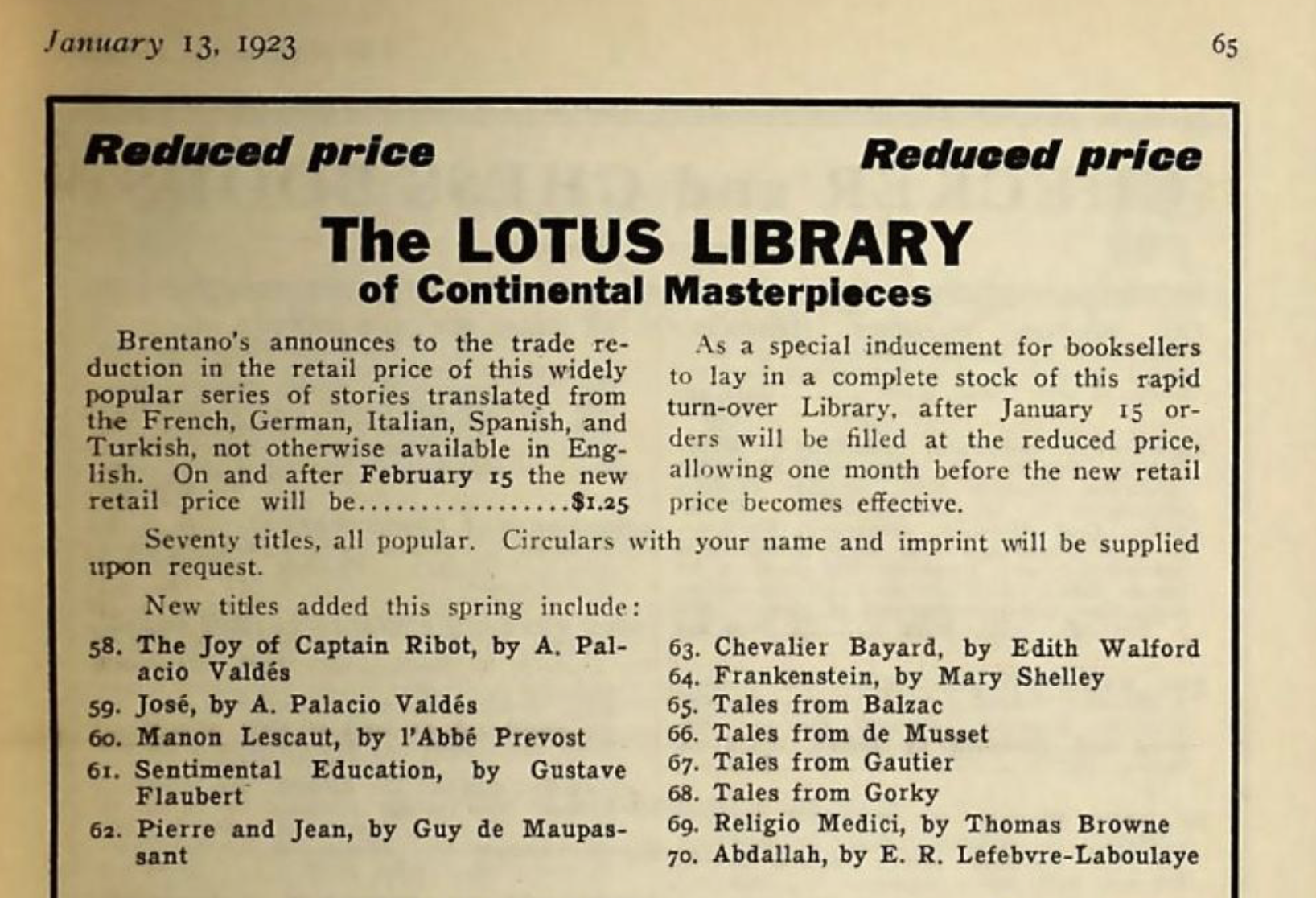 |
New Brentano’s Lotus Library series titles, #58 to #70. From Publisher’s Weekly, January 13, 1923. |
#58. The Joy of Captain Ribot, by A. Palacio Valdes (translated by Minna Caroline Smith, originally published by Downey, London, 1900)
#59. Jose, by A. Palacio Valdes (translated by Minna Caroline Smith, originally published by Brentano’s in 1901)
#60. Manon Lescaut, by L’Abbe Prevost (Illustrated by Leloir. Editions with illustrations by Maurice Leloir in English seem to originate in a translation published by Routledge in 1886 and reprinted numerous times after).
#61. Sentimental Education, by Gustave Flaubert (edited by Dora Knowlton Ranous; this edition seems to have been first published in Brentano’s Lotus Library in 1923).
#62. Pierre and Jean, by Guy de Maupassant (edited by Hugh Craig, Ernest Duez, and others. Originally published by Routledge (UK) in 1890, reprinted by Brentano’s in 1899 and 1921, the latter in the Wayside Library).
#63. Chevalier Bayard, by Edith Walford. (edited by Walford, originally published by Sampson Low, Son, and Marston (UK), 1868).
#64. Frankenstein, by Mary Shelley. (I cannot find anything distinguishing about this edition to identify where it was reprinted from).
#65. Tales from Balzac (An edition edited by Edgar Saltus first published by George J. Coombes in 1885 [source] and reprinted by Brentano’s as part of their Gems from the French series in 1892-1893 [source]. Also a version titled After-Dinner Stories by Balzac published by Brentano’s in 1913).
#66. Tales from de Musset (The full title is Tales from Alfred de Musset, copyright 1888. With an introduction by E. de V. Vermont. Published by Brentano’s as part of their Gems from the French series in 1892-1893 [source]. There is another Brentano’s edition, dated 1909 (copyright 1888), in their Wayside Library [source]).
#67. Tales from Gautier (Translated by Lafcadio Hearne, edited by Edgar Saltus. An edition in Brentano’s World Fiction Library was published in 1909).
#68. Tales from Gorky (Introduction by Ivan Strannik. Earlier edition published by J.F. Taylor & Co., NY, in 1902. Brentano’s published the title in their World Fiction Library (1910, 1923).
#69. Religio Medici, by Thomas Browne (I cannot find evidence this title was issued in the Lotus Library. The only place I find it is in the Publisher’s Weekly advertisement (left) and one other source, The Bookseller & Stationer, which lists the same titles as in the Publisher’s Weekly advertisement. Brentano’s did release, in 1915, a larger format (8vo) version of this title, which is the edition that can be found on WorldCat and online sellers. Thus, a potential ghost title).
#70. Abdallah, by E. R. Lefebvre-Laboulaye (Translated by Mary L. Booth. This seems to be originally issued by Sampson Low, Son, and Marston (UK) in 1868 and Scribner, Wilford & Co. (US) in 1869).
Additional titles allegedly in Brentano’s Lotus Library from entries in WorldCat. I cannot confirm these were actually two additional Lotus Library series titles. There are no advertisements or listings in contemporary literature.
#? Candide, or, All for the Best, by Voltaire (vignettes by Adrien Moreau). Brentano’s published an illustrated edition of this title in 1921, with a read leather cover (with illustrations in gold). WorldCat lists two copies of this Candide as being in the Lotus Library series, and the size (18cm) is about correct. I have not seen a copy of this title that is bound like typical Lotus Library titles, and I have not found a listing of this title in the series in contemporary literature.
#? Reflections, or Sentences and Moral Maxims, by François La Rochefoucauld (177 p. 1923, “Translated from the editions of 1678 and 1827 with introduction, notes, and some account of the author and his times by J.W. Willis Bund and J. Hain Friswell.” Brentano’s published a leather-bound edition of this title in 1908. I can’t find a copy in contemporary literature that says it’s part of the Lotus Library.
The distinctive illustrated dust jackets by A. Farquhar Tyler are found, in various versions, on Brentano’s and Collins Lotus Library. As noted above, it’s unclear when these jackets were first used or if they were first used in the UK or US. None of the books shown below are dated. I have not seen a Brentano’s Lotus Library title in a jacket that does not use the Tyler-designed jackets. Nor have I seen a Greening / Stanley Paul-era UK Lotus Library title with an illustrated jacket.
Alas, I can find just about nothing on A. Farquhar Tyler, besides these distinctive jacket designs. He seems to have been British (given evidence of participation in the Exhibition of the Royal Academy in 1917 (source).
A series lotus logo is included on the jacket spine. The flaps are blank,
Jacket backs include a list of the series titles.
Bindings are maroon with gold stamping. The lotus design continues from the earlier Greening series.
The title page indicates the New York imprint. Alas, Collins is listed as the publisher in the UK in all but one of the five copies of Brentano’s Lotus Library I have. Thus, Collins may have provided the printed books (and possibly even printed and bound books) to Brentano’s to sell in the US. Some series titles show Greening and Brentano’s imprint between 1908 and 1916.
This is the most extensive list of the five copies of Brentano’s Lotus Library I have, with about 70 titles.
Four additional jacket designs, with artwork borrowed from the Collins series. This artwork also shows up on some Greening titles.
Collins’ Lotus Library was issued from about 1920 to 1931, part of their array of reprint series (including the Collins’ Classics and Collins’ Novels). The jacket design was exuberant, as this updated copy of de Kock’s A Good Natured Fellow shows. The book is probably from about 1918 or not long after. Unique designs included illustrations by A. Farquhar Tyler complemented by bold design (and price of 2s/-) on the jacket spine. Advertising for Collins’ Novels series is included on the front jacket flap.
Lotus Library titles are listed on the back of the jacket, in this case, up to number 15. Collins’ Detective Novels are advertised on the rear jacket flap.
The reverse of the jacket includes a list of Collins’ Novels and Collins’ Detective Novels.
Bindings were somewhat exotic, with a repeating lotus flower pattern in purple cloth.
The exotic theme continues on the endpaper illustration.
The title page is also extensively decorated.
A list of Lotus Library titles is also included in the back of the book.
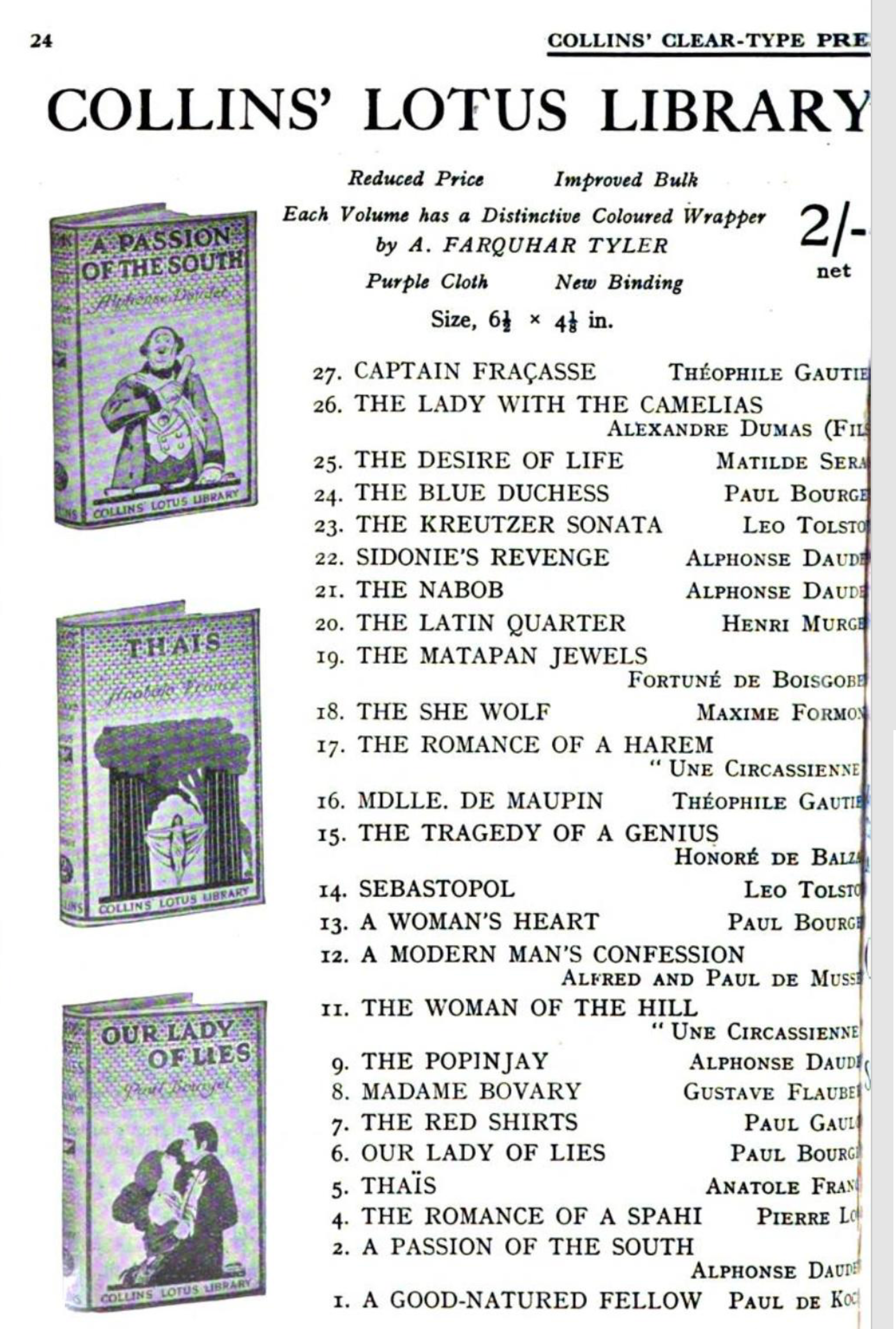 |
From Reference Catalogue of Current Literature, Volume 2, Part 2, 1928. |
Titles in the UK Collins Lotus Library. My count has 50 titles in total. See Greening Lotus Library list above for titles (marked * and **) not included in the Collins Lotus Library series.
The Adventures Of Baron Munchausen, by Anonymous
The Tragedy of a Genius, by Honore De Balzac
The Children Of Alsace, by Rene Bazin
Vathek, by William Beckford
The Matapan Jewels (aka, The Matapan Affair) by Fortune de Boisgobey
Andre Cornelis, by Paul Bourget
The Blue Duchess, by Paul Bourget
Our Lady Of Lies, by Paul Bourget
A Woman’s Heart, by Paul Bourget
The Romance Of A Harem, by “Une Circassienne”
The Woman Of The Hill, by “Une Circassienne”
*The Story Without a Name, by Barbey D’Aurevilly
A Passion Of The South, by Alphonse Daudet
The Nabob, by Alphonse Daudet
The Popinjay, by Alphonse Daudet
Sapho, by Alphonse Daudet
Sidonie’s Revenge, by Alphonse Daudet
The Black Tulip, by Alexander Dumas
The Lady with the Camelias, by Alexandre Dumas
Madame Bovary, by Gustave Flaubert
Salammbo, by Gustave Flaubert
The She-Wolf, by Maxime Formont
Thais, by Anatol France
Cagliostro & Co., by Franz Funck-Brentano
The Diamond Necklace, by Franz Funck-Brentano
The Blackmailers (“Le Dossier No. 113”), by Emil Gaboriau
The Red Shirts, by Paul Gaulot
Captain Fracasse, by Theophile Gautier
Mdlle. De Maupin, by Theophile Gautier
The Mummy’s Romance, by Theophile Gautier
La Faustin, by Edmond de Goncourt
The Outlaw Of Iceland (“Hans D’Islande”), by Victor Hugo
A Good-Natured Fellow, by Paul de Kock
Count Bruhl, by Joseph Kraszewski
Their Majesties The Kings, by Jules Lemaitre
The Adventures of Gil Blas of Santillane, by Alain René Le Sage
Madame Sans-Gene, by E. Lepellaitre
The Romance of a Spahi, by Pierre Loti
Woman And Puppet, Pierre Louys
A Woman’s Soul, by Guy de Maupassant
The Latin Quarter (“Scenes de la Vie de Boheme”), by Henri Murger
A Modern Man’s Confession, by Alfred and Paul de Musset
He And She, by Alfred and Paul de Musset
In Deep Abyss, by George Ohnet
The Poison Dealer, by George Ohnet
The Rival Actresses, by George Ohnet
The Desire Of Life, Matilde Serao
The Kreutzer Sonata, by Leo Tolstoy
Sebastopol, by Leo Tolstoy
Drink, by Emile Zola
*In Brentano’s Lotus Library, not in Greening’s Lotus Library
The Lotus Library books and jackets were redesigned in the late teens. This copy of Paul Gaulot’s The Red Shirts (#36) is undated but probably from the early 1920s. The A. Farquhar Tyler illustrations are maintained on the jackets, but the superfluous decorations around them are removed, simplifying the jackets. The series name and number remain on the spine, as does the price (2/6).
As with the earlier Collins Lotus Library copy above, the back of the jacket lists titles in the series, now 49 titles. The rear flap advertises Collins’ 2/- Novels.
The reverse of the jacket expands upon the rear flap and details the titles in Collins’ 2/- Novels series.
The purple binding with debossed lotus design is maintained from the earlier copy. The endpapers are blank, and the designs from the earlier version are gone.
A series list faces the simple half-title page. Two fewer titles are listed in comparison to the rear of the jacket.
The elaborate title page (and facing page) are greatly simplified from the earlier Collins version.
There is no date on the copyright page, but as noted, the book is probably from about 1919.
